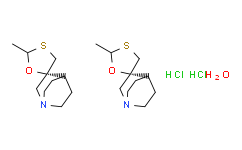| Description: |
Cevimeline hydrochloride hemihydrate, a novel muscarinic receptor agonist, is a candidate therapeutic drug for xerostomia in Sjogren's syndrome. The general pharmacol. properties of this drug on the gastrointestinal, urinary, and reproductive systems and other tissues were investigated in mice, rats, guinea pigs, rabbits, and dogs. The in vitro metab. of SNI-2011 was also evaluated with rat and dog liver microsomes. After oral administration, plasma concns. of SNI-2011 reached to Cmax within 1 h in both species, suggesting that SNI-2011 was quickly absorbed, and then decreased with a t1/2 of 0.4-1.1 h. The bioavailability was 50% and 30% in rats and dogs, resp. Major metabolites in plasma were both S- and N-oxidized metabolites in rats and only N-oxidized metabolite in dogs, indicating that a large species difference was obsd. in the metab. of SNI-2011. Sex difference was also obsd. in the pharmacokinetics of SNI-2011 in rats, but not in dogs. In the in vitro study, chem. inhibition and pH-dependent studies revealed that the sulfoxidn. and N-oxidn. of SNI-2011 were mediated by cytochrome P 450 (CYP) and flavin-contg. monooxygenase (FMO), resp., in both species. In addn., CYP2D and CYP3A were mainly responsible for the sulfoxidn. in rat liver microsomes. |
| References: |
[1]. Iga Y, Arisawa H, Ogane N, Saito Y, Tomizuka T, Nakagawa-Yagi Y, Masunaga H, Yasuda H, Miyata N. (+/-)-cis-2-methylspiro[1,3-oxathiolane-5,3'-quinuclidine] hydrochloride, hemihydrate (SNI-2011, cevimeline hydrochloride) induces saliva and tear secretions
[2]. Omori Y, Asari T, Maruyama K, Kusama H, Kojima M, Shibata N. Effects of pilocarpine hydrochloride and cevimeline on submandibular/sublingual salivation in rat xerostomia model produced by X-ray irradiation. Arzneimittelforschung. 2003;53(5):342-50.
[3]. Washio, Takuo; Kohsaka, Kazuhiro; Arisawa, Hirohiko; et al.Pharmacokinetics and metabolism of radiolabeled SNI-2011, a novel muscarinic receptor agonist, in healthy volunteers: Comprehensive understanding of absorption, metabolism and excretion using radi
[4]. Washio, Takuo; Kohsaka, Kazuhiro; Arisawa, Hirohiko; et al.Pharmacokinetics and metabolism of the novel muscarinic receptor agonist SNI-2011 in rats and dogs.Arzneimittel-Forschung (2003), 53(1), 26-33.
[5]. Arisawa, Hirohiko; Fukui, Kenji; Imai, Eiichi; et al.General pharmacological profile of the novel muscarinic receptor agonist SNI-2011, a drug for xerostomia in Sjogren's syndrome. Arzneimittel-Forschung (2002), 52(4), 225-232. |

 To enhance service speed and avoid tariff delays, we've opened a US warehouse. All US orders ship directly from our US facility.
To enhance service speed and avoid tariff delays, we've opened a US warehouse. All US orders ship directly from our US facility.




















